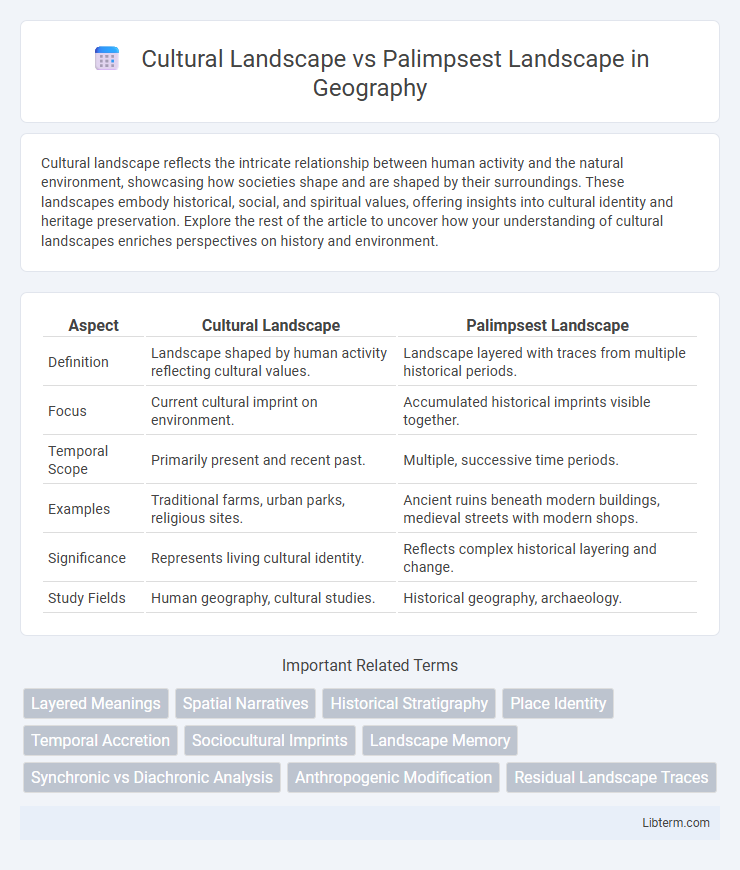Cultural landscape reflects the intricate relationship between human activity and the natural environment, showcasing how societies shape and are shaped by their surroundings. These landscapes embody historical, social, and spiritual values, offering insights into cultural identity and heritage preservation. Explore the rest of the article to uncover how your understanding of cultural landscapes enriches perspectives on history and environment.
Table of Comparison
| Aspect | Cultural Landscape | Palimpsest Landscape |
|---|---|---|
| Definition | Landscape shaped by human activity reflecting cultural values. | Landscape layered with traces from multiple historical periods. |
| Focus | Current cultural imprint on environment. | Accumulated historical imprints visible together. |
| Temporal Scope | Primarily present and recent past. | Multiple, successive time periods. |
| Examples | Traditional farms, urban parks, religious sites. | Ancient ruins beneath modern buildings, medieval streets with modern shops. |
| Significance | Represents living cultural identity. | Reflects complex historical layering and change. |
| Study Fields | Human geography, cultural studies. | Historical geography, archaeology. |
Defining Cultural Landscape
Cultural landscape refers to geographic areas shaped by human interaction with the environment, reflecting cultural practices, values, and historical events visible in physical forms such as architecture, agriculture, and infrastructure. It encompasses tangible and intangible heritage, illustrating the relationship between people and their natural surroundings over time. This contrasts with palimpsest landscapes, where multiple layers of cultural imprints overlap, allowing the study of sequential historical transformations within a single spatial context.
Understanding Palimpsest Landscape
Palimpsest landscapes embody the layered history of human activity, revealing successive cultural imprints preserved in the environment. Unlike cultural landscapes that represent a unified cultural expression, palimpsest landscapes showcase overlapping, often contrasting historic periods and land uses, making them vital for archaeological and heritage studies. Understanding palimpsest landscapes requires analyzing spatial patterns, material remnants, and historical records to interpret the complex narratives embedded within these evolving environments.
Historical Evolution of Landscapes
Cultural landscapes represent the visible imprint of human activity shaped over time, reflecting historical evolution through architectural styles, land use patterns, and settlement structures. Palimpsest landscapes embody layered histories where successive cultural and natural modifications overlap, revealing complex temporal narratives beneath the surface. Understanding these landscapes involves analyzing archaeological evidence, archival records, and spatial configurations to trace the chronological transformation of human interaction with the environment.
Key Differences: Cultural vs Palimpsest Landscapes
Cultural landscapes represent the visible imprint of human activity on the natural environment, shaped by cultural practices, beliefs, and values over time. Palimpsest landscapes contain multiple overlapping layers of historical and cultural modifications, showcasing diverse eras and influences coexisting simultaneously. The key difference lies in cultural landscapes reflecting a singular dominant cultural influence, while palimpsest landscapes reveal a complex, stratified story of successive human interventions and transformations.
Layers of Meaning in Landscapes
Cultural landscapes embody layers of meaning through the interactions between human activity and natural environments, reflecting historical, social, and ecological processes over time. Palimpsest landscapes reveal visible traces of multiple eras, where past imprints coexist with contemporary uses, creating complex, overlapping narratives embedded in the terrain. These layers of meaning enable the interpretation of evolving identities and cultural memory within physical spaces, emphasizing continuity and transformation in landscape analysis.
The Role of Human Activity in Landscape Formation
Cultural landscapes are shaped by continuous human activity that integrates natural elements with social, economic, and spiritual practices, reflecting a living interaction between people and their environment. Palimpsest landscapes exhibit layered histories where successive human interventions overwrite previous ones, creating a complex tapestry of cultural imprints visible in architecture, land use, and settlement patterns. Both concepts highlight the pivotal role of human agency in transforming and preserving landscapes over time, encoding collective memory and identity within the physical terrain.
Case Studies: Notable Examples Worldwide
Cultural landscapes represent environments shaped by the combined works of nature and humans, such as Machu Picchu in Peru, where ancient Incan architecture integrates harmoniously with the surrounding mountain terrain. Palimpsest landscapes reveal layers of history and cultural transformations, exemplified by Rome, Italy, where archaeological sites, medieval structures, and modern buildings coexist, reflecting continuous urban evolution. Case studies like Angkor Wat in Cambodia highlight the transition from religious temple complexes to modern tourism hubs, showcasing both cultural persistence and reinterpretation.
Interpreting Landscape Change Over Time
Cultural landscapes reveal human interactions with the environment, embodying traditions, land use, and historical modifications that shape current forms. Palimpsest landscapes demonstrate layered histories where different temporal imprints coexist, allowing interpretation of past societies, evolving land use patterns, and dynamic environmental transformations. Understanding landscape change over time through these frameworks aids in preserving heritage, guiding sustainable development, and decoding complex multi-period spatial narratives.
Cultural Landscape Preservation and Challenges
Cultural Landscape preservation involves maintaining the historical, social, and environmental values embedded in landscapes shaped by human interaction over time. Palimpsest Landscapes present unique challenges due to overlapping layers of cultural imprints, requiring sensitive approaches to distinguish and conserve diverse historical periods. Effective preservation strategies must balance protecting heritage integrity while accommodating contemporary land use pressures and environmental changes.
The Future of Landscape Studies
Cultural landscapes represent living, evolving environments shaped by human interaction, while palimpsest landscapes contain layered historical imprints revealing successive cultural modifications. The future of landscape studies emphasizes integrating advanced geospatial technologies and interdisciplinary approaches to decode these complex narratives for sustainable heritage management. Embracing dynamic frameworks enhances understanding of temporal changes and supports adaptive conservation strategies.
Cultural Landscape Infographic

 libterm.com
libterm.com